 My chosen field is said to be a man’s world. Back in college where one interacts with more males and t-squares than females, important and close friendships between opposite sexes is as natural as breathing. And after each semester of hard work and sleepless nights, breaks and summer vacations were celebrated with parties full of booze. (Parents, no need to worry. As long as you know who your kids’ friends are there is no reason to panic.)
My chosen field is said to be a man’s world. Back in college where one interacts with more males and t-squares than females, important and close friendships between opposite sexes is as natural as breathing. And after each semester of hard work and sleepless nights, breaks and summer vacations were celebrated with parties full of booze. (Parents, no need to worry. As long as you know who your kids’ friends are there is no reason to panic.)
The 1st time we had a drinking spree at home was my 19th birthday and that day marked the beginning of a series of inuman either with friends and relatives. My parents were always there enjoying every bit – mom drinking liters of cola while dad with just half a bottle of beer that’s consumable for the whole night.Social drinking eventually played a huge part in my kind of work for a lot of reasons. Dealing with colleagues, clients, consultants, suppliers, contractors, even laborers. Also like Ting said, drinking is a way of unwinding. It’s a person’s way of de-stressing from a hard day’s knock although now it’s been quite a while since I went into such a pinoy-style gathering and my tolerance to alcohol has diminished considerably.
Pulutan is a kind of food that is served as accompaniment to a drink. It comes in different kinds like meat, fish, nuts, chips. It’s prepared in different ways… fried, steamed. Basically, it is anything that makes drinking enjoyable.
 Too bad I forgot what Dad & Mom normally prepared for pulutan. My guess, menudo or inihaw na tilapia (broiled tilapia over live charcoal). With my friends, I do remember that isaw has always been a favorite. It could be IUD (chicken intestines) from a street vendor (IUD photo is courtesy of GUTS. GRIT. GUMPTION.) or crispy chitterlings as prepared by my friend’s mom. Here in Beijing we occasionally go to this English bar with Pinoy musicians, an equally Pinoy chef, and among our favorites are sisig (a sizzling dish of spicy chopped pork head & liver) and chicharong baboy (pork rinds).
Too bad I forgot what Dad & Mom normally prepared for pulutan. My guess, menudo or inihaw na tilapia (broiled tilapia over live charcoal). With my friends, I do remember that isaw has always been a favorite. It could be IUD (chicken intestines) from a street vendor (IUD photo is courtesy of GUTS. GRIT. GUMPTION.) or crispy chitterlings as prepared by my friend’s mom. Here in Beijing we occasionally go to this English bar with Pinoy musicians, an equally Pinoy chef, and among our favorites are sisig (a sizzling dish of spicy chopped pork head & liver) and chicharong baboy (pork rinds).
However, when it comes to pulutan it’s the other way around over here as it is alcohol that accompanies food. The Chinese traditionally drink while eating so you can imagine the scenario as it’s considered improper to say no to the host especially if he’s our Client. Gan Bei! ( Pronounced ‘gam bay’, meaning ‘dry cup’) You are expected to empty the glass. The good thing is that drinking with food decreases the rate of alcohol absorption and may also reduce the amount consumed.
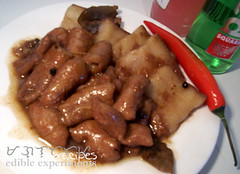 For LP6, here is the recipe of our carinderia adobong isaw ng baboy (stewed chitterlings, chit’lins or pork intestines, whatever) as I remember it from my Dad. It’s not standard turo turo (eatery) food but a delicacy especially popular with the common masses served as pulutan. Oh was I glad to find that the chitlins being sold here in supermarkets are really clean.
For LP6, here is the recipe of our carinderia adobong isaw ng baboy (stewed chitterlings, chit’lins or pork intestines, whatever) as I remember it from my Dad. It’s not standard turo turo (eatery) food but a delicacy especially popular with the common masses served as pulutan. Oh was I glad to find that the chitlins being sold here in supermarkets are really clean.
Continue reading “LP6: Adobong Isaw”

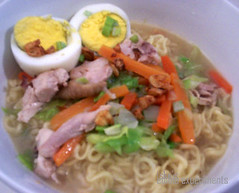 I’ve been dreaming of cooking chicken mami (noodle soup) since I had
I’ve been dreaming of cooking chicken mami (noodle soup) since I had 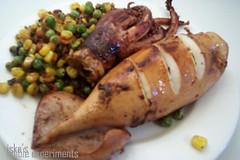 For my kind of work, I read or browse tru mags and books or surf the net for inspiration before I start conceptualizing for new designs. It goes without saying that I also do this to plan ahead about what to cook. As I always check out fellow pinoy food blogs for recipes I haven’t tried or the ones that seems forgotten, I found one about stuffed pusit (squid) that teleported me back to my dad’s old office when I was a little girl. There was some kind of a celebration, must be the opening of the office itself or the company’s anniversary, and one of mom’s main dish was a huge stuffed squid.
For my kind of work, I read or browse tru mags and books or surf the net for inspiration before I start conceptualizing for new designs. It goes without saying that I also do this to plan ahead about what to cook. As I always check out fellow pinoy food blogs for recipes I haven’t tried or the ones that seems forgotten, I found one about stuffed pusit (squid) that teleported me back to my dad’s old office when I was a little girl. There was some kind of a celebration, must be the opening of the office itself or the company’s anniversary, and one of mom’s main dish was a huge stuffed squid.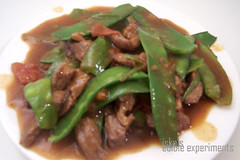 I remember those days a long time ago every time we were in a Chinese restaurant I always wonder how they can cook the meat so tender in such a short time whilst the vegetable remain crisp and the sauce thick and bubbly. I observed firsthand a real northern Chinese cook their veggies (of course, ate Vi our enterpreter here), tried few stir-fry recipes I found online, discovered the technique myself and now I couldn’t stop experimenting w/ different vegetables.
I remember those days a long time ago every time we were in a Chinese restaurant I always wonder how they can cook the meat so tender in such a short time whilst the vegetable remain crisp and the sauce thick and bubbly. I observed firsthand a real northern Chinese cook their veggies (of course, ate Vi our enterpreter here), tried few stir-fry recipes I found online, discovered the technique myself and now I couldn’t stop experimenting w/ different vegetables.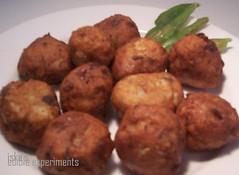 I steamed quite a large piece of fish in soy sauce yesterday and still have some leftover that I decided to make fish balls. Here’s the recipe…
I steamed quite a large piece of fish in soy sauce yesterday and still have some leftover that I decided to make fish balls. Here’s the recipe…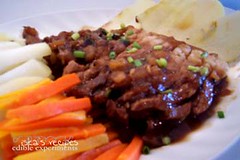 I checked my stats and the most visited pages are my hamonado recipes followed by
I checked my stats and the most visited pages are my hamonado recipes followed by  Tonight is the eve of the
Tonight is the eve of the 

 For
For 
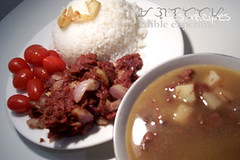 What else am I going to miss? Corned beef. When Ate (my sis) was here autumn last year, I told her we couldn’t find corned beef in Beijing so she gave me some in packets to bring back here. Now we’ve finished the last packet. Sobs! On the other hand,
What else am I going to miss? Corned beef. When Ate (my sis) was here autumn last year, I told her we couldn’t find corned beef in Beijing so she gave me some in packets to bring back here. Now we’ve finished the last packet. Sobs! On the other hand,